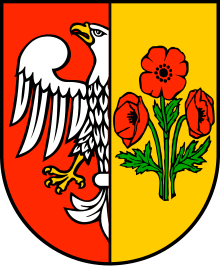
Makowski (feminine: Makowska; plural: Makowscy) is a Polish surname with regional variations across Slavic countries, such as Makovsky in Russia.

Makowski (feminine: Makowska; plural: Makowscy) is a Polish surname with regional variations across Slavic countries, such as Makovsky in Russia.
The surname Makowski relates to a location, as it was common among nobility (the suffix -ski being the equivalent of the English "of", the Germanic "von" and the French "de"). In this case, it is likely indicating one of the towns named Maków or Makowo. [1]
The etymological root "Mak" translates to "Poppy" in Slavic languages.
| Language | Masculine | Feminine |
|---|---|---|
| Polish | Makowski | Makowska |
| Belarusian (Romanization) | Макоўскі (Makoŭski, Makowski) | Макоўская (Makouskaya, Makoŭskaja, Makowskaya) |
| Czech/Slovak | Makovský | Makovská |
| Hungarian | Makovszky, Makovszki | |
| Latvian | Makovskis | Makovska |
| Lithuanian | Makauskas | Makauskienė (married) Makauskaitė (unmarried) |
| Macedonian | Маковски (Makovski) | Маковска (Makovska) |
| Romanian/Moldovan | Macovschi, Macovschii | |
| Russian (Romanization) | Маковский (Makovskiy, Makovskii, Makovskij, Makovsky, Makovski) | Маковская (Makovskaya, Makovskaia, Makovskaja) |
| Ukrainian (Romanization) | Маковський (Makovskyi, Makovskyy, Makovskyj, Makovsky) | Маковська (Makovska) |
| Other | Makowsky, Makofsky, Makofski |
The "Polish Armorial" reference by the heraldist Kasper Niesiecki lists several noble (szlachta) people with the name Makowski belonging to different heraldic clans (herb), including: [2]

The Dorpat Voivodeship was a unit of administrative division and local government in the Duchy of Livonia, part of the Polish–Lithuanian Commonwealth, from 1598 until the Swedish conquest of Livonia in the 1620s. The seat of the voivode was in the town of Dorpat (Tartu), while the regional assembly (sejmik) for the whole province of Livonia was located in Wenden. The area of the Dorpat Voivodeship was app. 9,000 square kilometers, and it had two senators in the Senate of the Polish–Lithuanian Commonwealth.
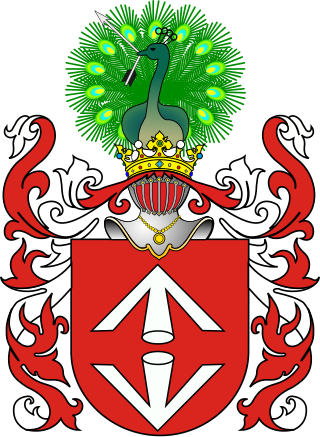
Bogoria is a Polish coat of arms. It was used by several szlachta families in medieval Poland and later under the Polish–Lithuanian Commonwealth, branches of the original medieval Bogoriowie family as well as families connected with the Clan by adoption.

Rawa (Rawicz), is a coat of arms of Polish origin. It was borne by several noble families of Polish–Lithuanian Commonwealth, Russian Empire and Ukraine.

Nieczuja is a Polish coat of arms that was used by many szlachta families in the Polish–Lithuanian Commonwealth.
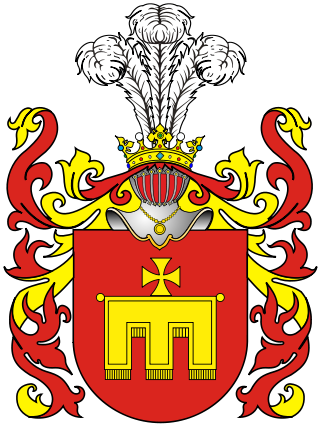
Radwan is a Polish knights' clan (ród) and a Polish coat of arms used by the szlachta.
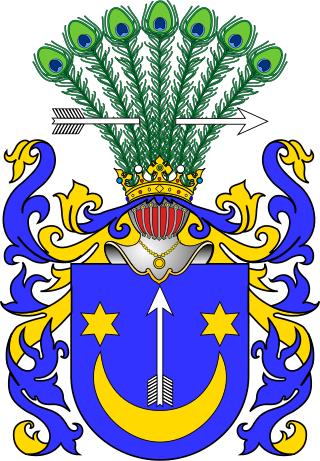
Sas or Szász is a Central European coat of arms. It was borne since the medieval period by several Transylvanian-Saxon Hungarian, Ruthenian, Ukrainian, and Polish-Lithuanian noble families. The house was once a mighty princely and ducal house with origins in Saxony, Transylvania, Hungary and Ruthenia.

Herb Prus III - is a Polish coat of arms. It was used by several szlachta families in the times of the Polish–Lithuanian Commonwealth.

The Inflanty Voivodeship, or Livonian Voivodeship, also known as Polish Livonia, was an administrative division and local government in the Polish–Lithuanian Commonwealth, since it was formed in the 1620s out of the Wenden Voivodeship and lasted until the First Partition of Poland in 1772. The Inflanty Voivodeship was one of the few territories of the Polish–Lithuanian Commonwealth to be ruled jointly by Poland and Lithuania.

The House of Chodkiewicz was one of the most influential noble families of Lithuanian-Ruthenian descent within the Polish–Lithuanian Commonwealth in the 16th and 17th century.
Makovsky, derived of the Polish surname Makowski, is a habitational name for someone from a place called Makov.
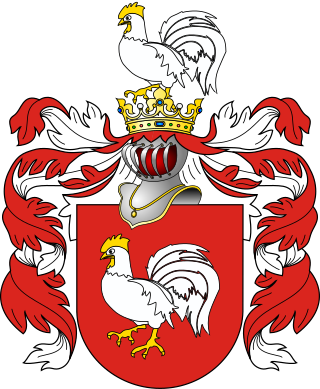
Kur is a Polish coat of arms. It was used by several noble families forming a Clan of Kur in the times of the Kingdom of Poland and the Polish–Lithuanian Commonwealth. It is noted during the reign of the Jagiellon dynasty and illustrated with its original name in the work of Bartosz Paprocki "Herby Rycerstwa Polskiego" in 1584. Furthermore, it is published in the work of Szymon Okolski in 1641. and several other publications
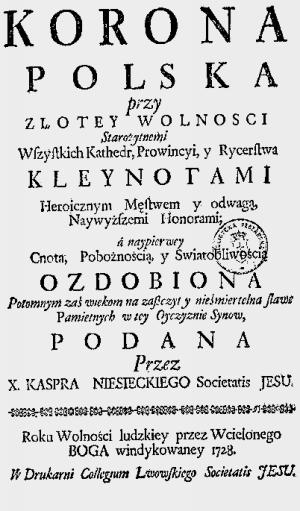
Kasper Niesiecki, also known as Kacper Niesiecki, was a Polish heraldist, Jesuit, lexicographer, writer, theologian and preacher.
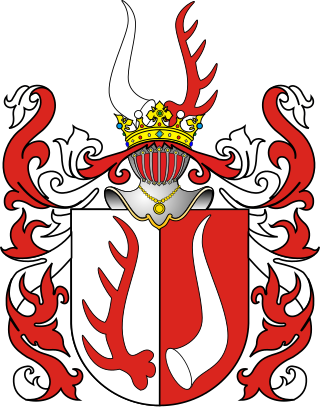
Rogala is a Polish coat of arms, likely imported from Germany to Poland in 1109 by the Rogala or the Ribersztein family, that then added the second horn. It was used by several szlachta families in the times of the Polish–Lithuanian Commonwealth.

Mikołaj Błociszewski - a court knight and the deputy of King Jogaila for negotiations with the Teutonic Knights. He was Castellan of Sanok (1401–1415), Judge of Poznań (1415–1419) and Lord of Greater Poland.

Konstanty Ludwik Plater, was Castellan of Troki from 1770, voivode of Mstislavl from 1758 to 1770, Castellan of Polotsk from 1754 to 1758, the great Lithuanian Magnus Scriptor from 1746 to 1754, Maréchal of the Lithuanian Tribunal in 1754, and Starosta of Livonia and Dyneburg. In 1754, he was awarded with the Order of White Eagle, Knight of the Order of Saint Stanislaus, and the Russian Order of St. Alexander Nevsky. Married to Countess Augustina Oginska on 16 Aug 1744.
Krzyszt of Czarniecki of the Łodzia coat of arms was a Polish nobleman and starosta of Żywiec.
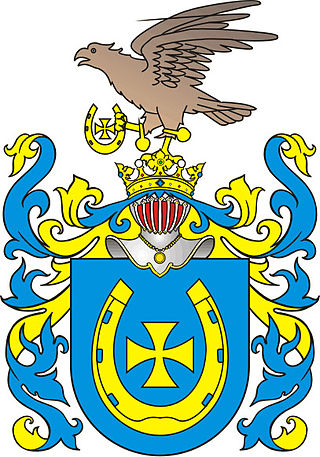
Daniel Pawłowski was a Polish Jesuit, theological writer.

Tadeusz Mikołaj Thullie was the last Royal Secretary of King Stanisław August Poniatowski. He was ennobled in 1767, receiving the Prawdzic coat of arms. He was the son of Adam Thullie, lieutenant general of the Polish army, and Katarzyna née Fontana, a sister of royal architect Jakub Fontana.

The Roszkowski family is a Polish noble (szlachta) family. Since Polish adjectives have different forms for the genders, Roszkowska is the form for a female family member. The family has Ogończyk coat of arms.